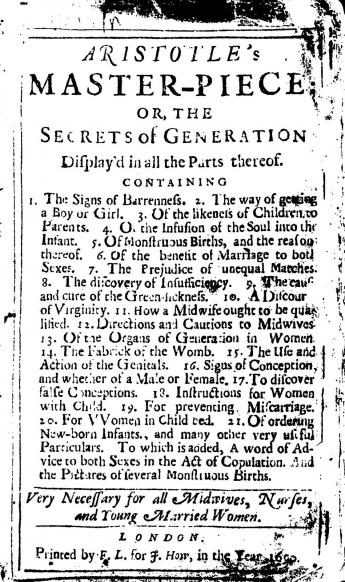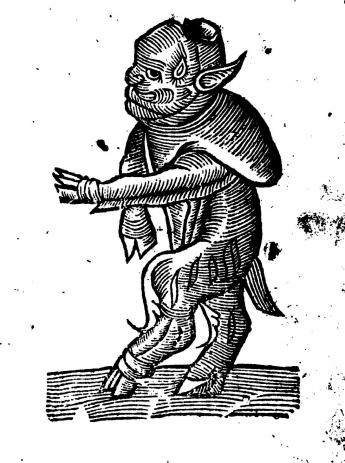Livres à lire dune seule main - Aristotles Master-Piece

By Jack Lynch
Aristotle’s Master-Piece;
or,
The Secrets of Generation
Display’d in All the Parts Thereof:
Containing
1. The Signs of Barrenness. 2. The Way of Getting a Boy or Girl. 3. Of the Likeness of Children to Parents. 4. Of the Infusion of the Soul into the Infant. 5. Of Monstruous Births, and the Reasons Thereof. 6. Of the Benefit of Marriage to Both Sexes. 7. The Prejudice of Unequal Matches. 8. The Discovery of Insufficiency. 9. The Cause and Cure of the Green Sickness. 10. A Discourse of Virginity. 11. How a Midwife Ought to Be Qualified. 12. Directions and Cautions to Midwives. 13. Of the Organs of Generation in Women. 14. The Fabrick of the Womb. 15. The Use and Action of the Genitals. 16. Signs of Conception, and Whether of a Male or Female. 17. To Discover False Conception. 18. Instructions for Women with Child. 19. For Preventing Miscarriage. 20. For Women in Child-Bed ... To Which Is Added, a Word of Advice to Both Sexes in the Act of Copulation, and the Pictures of Several Monstrous Births:
Very Necessary for All Midwives, Nurses, and Young-Married Women.
London, 1690.
Probably the most notorious seventeenth-century sex manual bore the strange title Aristotle’s Masterpiece. This book bears a fake author’s name — the Greek philosopher had nothing to do with it — in order to give the work some measure of respectability. The ruse didn’t work; Aristotle’s Masterpiece was banned in Britain until the 1960s. But the prohibition didn’t keep it from circulating: it was one of the most notorious, and widely distributed, sex books in the English language.
The long title page gives little idea of the contents. True, the promised “pictures of several monstrous births” offers a kind of prurient glance at gruesome birth defects. But the book was notorious for other reasons. It wasn’t marketed to midwives, and “nurses and young-married women” were not the real audience. Much of the book was read as pornography, pure and simple.
From a twenty-first-century point of view, the seventeenth-century pornography doesn’t always seem very pornographic. In fact Aristotle’s Masterpiece sometimes reads more like a sermon than a sex guide. “It plainly appears in Holy Writ,” the book declares, “that this glorious Vniverse, bespangled with gaudy Fires, and every where adorned with wonderful objects, proclaiming the Wisdom and Omnipotence of the Great Work-Master, who in Six Days Erected all Things for his Pleasure.” Maybe erected is a dirty pun, but the sentiment is wholesome enough, and the point is that God created sex for humanity’s pleasure — not a heretical belief, but one embraced by the Puritans themselves in seventeenth-century England. “That Marriage is an Honourable State,” writes the author, “ordained by God in Paradice, and since Confirmed by our Blessed Saviour, who wrought his first Miracle at a Wedding, I hope none will deny; therefore it is convenient that Parents well take care of their Daughters Chastity.” No need to blush there.
But once the book gets going, there’s little doubt that the book would be categorized as what Jean-Jacques Rousseau called a “livre à lire d’une seule main,” a “book to be read with one hand.” In fact its very popularity makes it difficult to study today. We’re not even certain when the first edition was printed; few copies of the early editions survive, since most of them have been read (and, no doubt, otherwise used) until they fell apart.
(Posted in Jack Lynch’s blog You Can Look It Up. Presented here by permission of the author.)

